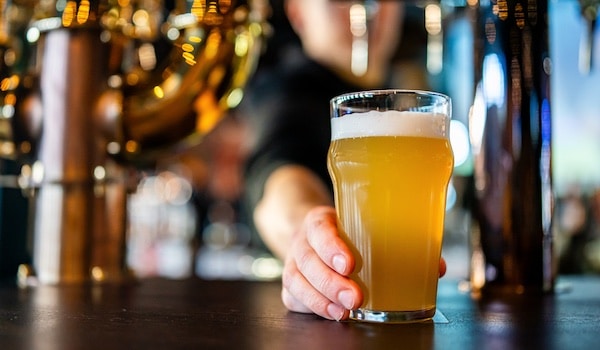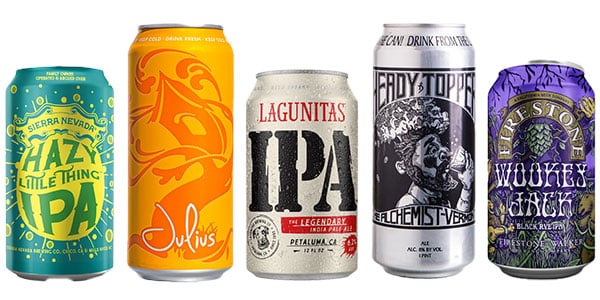
In This Article
Introduction to India Pale Ale
When most people think of craft beer, they’re likely picturing an IPA in a pint glass served by a bearded bartender. While this is a fairly reductive perception, there’s also plenty of truth behind it. India Pale Ale has been the category’s standard bearer for almost as long as the craft beer phenomenon has been going.
These hoppy concoctions are by far the most popular option most craft beer fans go for at the pub or liquor store, and for good reason. Not that lagers, stouts, or saisons don’t have their merits (far from it), but IPA has captured adventurous drinkers like no other beer style.
Here’s everything you need to know about IPA:
History of the India Pale Ale
Where it all began:
- 18th-century England: The go-to craft beer has its roots in British pale ales. These were brewed using coke-fired malt, which allowed barley to be roasted, creating a paler and clearer beer than was the norm.
- How it got the name: Pale ales were eventually brewed with higher alcohol content and more hops to survive long voyages to India, hence the name!
- Then vs. now: Brewing has come a long way since the days when IPA sailed the high seas, and even modern British IPAs are different than the original. Today’s more pronounced (and cleaner) hop profiles with more effervescent aromas weren’t achievable back then. There also wasn’t the variety in IPAs as there is now (more on that below).
What Defines an IPA?
Core characteristics:
- High hop content: This is one of the defining features of an IPA. These early brewers used hops to preserve the beer over long voyages. And while that’s hardly why a trendy craft brewer dry-hops their hazy IPA, it’s still what separates these beers from a brown ale or even a standard pale ale.
- Alcohol content: Compared to traditional pale ales, IPAs are much stronger, at about 6% and above. The added hop profile is used to complement the booziness.
- Color and clarity: This factor means less in the age of Black or New England IPAs. However, the caramel or amber hues with some clarity were hallmarks of early IPA and differentiated them from porters and lagers.
Different Types of IPAs

West Coast IPA
These beers were brewed with less malt character than their British counterparts, but were aggressively hopped for bitterness and flavor. Many of these examples boast between 40 and 70 IBUs (International Bitterness Units), but even more diabolical beers are out there.
English IPA
The original is still exploring, even with the myriad options available at the pub. This beer is brewed with malt sweetness, manageable bitterness, and floral aromas that stand up to this day. You’ll find these everywhere in the UK, but more American craft brewers have started to pay homage to the OG.
East Coast IPA:
A more balanced and malty version of the American IPA, this style has mostly gone by the wayside in favor of juicier options (read on…).
New England IPA (Hazy IPA)
What started in backwoods breweries like the Alchemist and Treehouse has completely taken over the craft beer industry. For fans of juicy, fruity, and less bitter versions of your standard IPA, beers like Julius and Heady Topper were a revelation. These IPAs are brewed with dry-hop additions and less filtration to create a cloudy and flavorful beer that packs in the flavor.
Session IPA:
These beers are essentially pale ales that have a higher hop profile. Brewed to have lower alcohol than a traditional IPA, a “session” beer is designed for having a few. These became wildly popular in the early 2010s and are ideal for longer taproom or beach hangouts.
Double or Imperial IPA:
The originators would probably not imagine a beer stronger and hoppier than their initial creations. But craft brewers are adventurous, so they’ve added more malt to the boil for a higher alcohol content and hopped the living daylights out of these beers for even more bitterness and flavor to mask the booze. The “double” moniker can be applied to any of the other IPA varieties as it pertains to alcohol content.
Black IPA
Also known as Cascadian Dark Ale, this beer style combines the roastiness and maltiness of a black ale or porter with the piney hoppiness of West Coast IPAs. They’ve gone in and out of style, but anyone who’s tasted Firestone Walker’s Wookie Jack wants this beer style to stick around!
Milkshake IPA
An offshoot of New England IPA, these beers are characterized by their massive hop flavors and sweetness from adjuncts like fruit or oats. Lactose, an unfermentable sugar, is generally added for sweetness and a creamy texture. These beers are positively decadent and have divided (the ever-argumentative) craft beer nerds since they became popular in the 2010s.
Belgian IPA
This niche uses a Belgian yeast strain to gain specific esters and flavors often found in beer styles like Dubbels and Tripels.
How IPAs Are Brewed
Common Hop Varieties
American “C” hops like Citra, Mosaic, Cascade, and Chinook are the most commonly used in brewing all styles of IPA, and these will bring a wide variety of flavors and drinking experiences depending on how they’re used. Cascade will bring piney flavors while Citra will offer intense citrus and grapefruit character to a beer.
Malt Choices
The role of malt in brewing an IPA is largely determined by the sub-style you want to brew. There’s a relatively wide variety of IPA, and how malt is incorporated plays a massive role in what color these beers turn out and what flavors they bring. Roasted malts are used for Black IPA, Milder barley like Maris Otter will yield traditional English IPA. Malt adjuncts like oats or wheat are often used for Hazy IPAs.
Yeast
This ingredient determines so much in a beer that it’s surprising so many drinkers aren’t aware of it at all. Without getting too deep into the science of yeast, brewers should carefully choose the specific strain to match the style of IPA they want to make.
Hopping Methods
It’s not just which hops you’re using; how you use them is also paramount. It all comes down to when you’re adding hops in the brewing process. If these are dry-hopped, you’ll get more of the juicy flavors; if they’re added throughout the boil, you’ll get some of the classic American IPA bitterness and dryness.
Fermentation & Temperature
Again, we can’t go too in-depth into the process, but controlling the temperature of the boil impacts how flavors are derived from the hops. Fermentation temperature is also crucial as this controls how the yeast converts sugars into alcohol.
Tips for Drinking IPAs
Why Freshness Matters
Hop profiles tend to fade over time as some of the particulates drop out of the beer, which is why IPA is synonymous with freshness. New England-style, milkshake, and double IPAs are best consumed within a few months of canning.
Best Glassware & Serving Temp
The standard shaker pint is perfectly serviceable when it comes to an IPA, but the absolute best glass to use for capturing the aromas and preserving the carbonation of this style is a goblet or chalice. Also, don’t be afraid to let an IPA (especially darker and maltier ones) warm up a bit.
Ideal Food Pairings
It’s best to match strength with strength when pairing beer with foods, so flavorful or spicy dishes are best with an IPA. You won’t have to worry about a curry’s aromas or spice overpowering a piney West Coast IPA; strong cheeses or indulgent pastas won’t get in the way of a nice Hazy or Belgian IPA.
IPA Tasting Expectations
There is simply too much variety within the style, but you should expect intense (but not overpowering) flavor. Whether it’s bitterness or sweetness, an IPA will pack a punch!
Common Misconceptions
- “All IPAs are extremely bitter”: Simply not true! Look at the IPA styles discussed before; you’ll find sweet flavors all over the category.
- Confusing strength with flavor: With techniques like dry hopping or using specific malts, brewers can squeeze plenty of flavor out of lower alcohol beers. There’s a reason session IPA was so popular!
- Thinking haze = quality: This is one of the most divisive issues in beer, and for good reason. When New England IPA swept the industry, every beer fan was looking for one thing: haze. Many of these beers were great, but it quickly became a crutch for less experienced (or worse, lazy) brewers looking to mask off flavors with intense hop additions. The landscape has fortunately evened out, and styles like West Coast IPA are back in vogue.
IPA in the Craft Beer Revolution
Why IPA Became Craft Beer’s Flagship
The original brewpubs and craft breweries specialized in amber ales and dry, bitter, and piney IPAs. While amber ale is largely forgotten, West Coast IPAs from California staples like Lagunitas and Stone took over the world.
Impact of Microbreweries & Homebrewers
Some of the best innovation happens in tiny brewpubs or even garages, and these intrepid (and zany) brewers have been responsible for plenty of breakthroughs in brewing IPAs.
Global Reach
Take a look at cities like Copenhagen and London, and you’ll find their beer scenes stacked with American-style craft breweries turning out amazing West Coast or Hazy IPAs. There are countless craft breweries across the globe making modern beer, and many of them got their inspiration from IPA!
Conclusion
When you think about it, it’s not all that surprising that this hoppy brew took over the beer world. IPA offers one of the most diverse playgrounds for brewers to explore and drinkers to enjoy. So keep an open mind when trying new styles, but you can bet there will be an IPA on draft at the brewpub or taproom!



